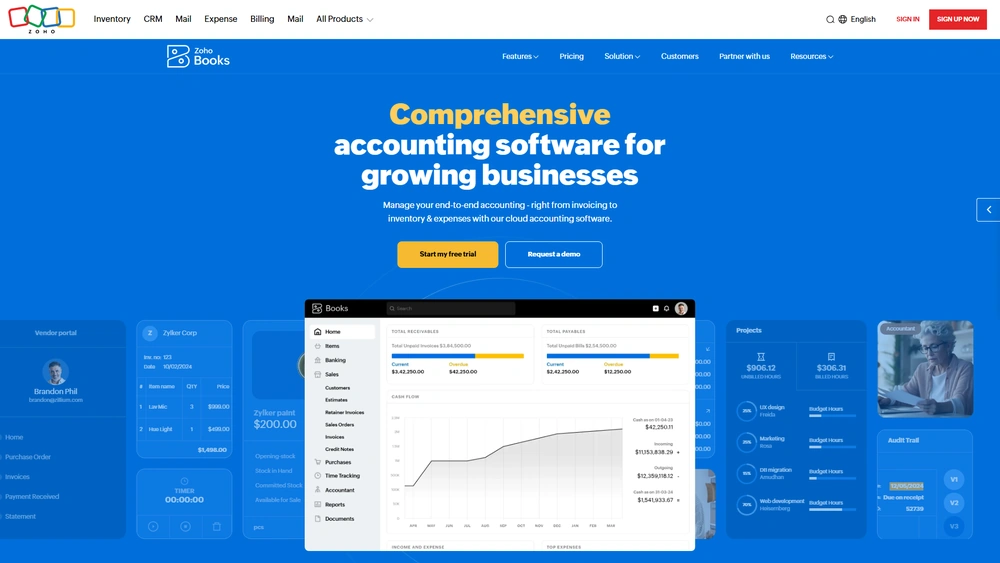Zoho Books Overview & 2025 Industry Position
Zoho Books is a cloud-based accounting software platform from the Zoho Corporation, designed primarily for small businesses and growing enterprises seeking a modern, automated approach to bookkeeping, invoicing, and financial management. With over 90 million Zoho users globally, Zoho Books benefits from tight ecosystem integrations and a robust feature set evolved specifically for international accounting compliance, automation, and affordability. In 2025, Zoho Books sits at the intersection of fintech flexibility and SMB digitization—offering customizable automation, multi-currency invoicing, and tax-ready reporting from a single centralized dashboard, all while remaining competitively priced for budget-conscious teams.
From Launch to 2025: Zoho Books’s Journey
Zoho Books first launched in 2011 as part of Zoho’s expanding suite of business software tools. Initially focused on basic invoicing and bookkeeping for freelancers and micro businesses, it has since transformed into a comprehensive accounting platform catering to multi-user teams, cross-border transactions, and departmental roles. Major milestones include:
- 2011: Zoho Books officially launches with core accounting tools.
- 2013: Introduces mobile apps for iOS and Android.
- 2017: Adds GST-compliance support for India.
- 2020: Deep integrations with Zoho CRM, Zoho Inventory, and payment gateways.
- 2023: Launch of AI-powered features for reconciliation and anomaly detection.
- 2025: Expands industry-specific workflows and real-time global tax support.
In 2025, Zoho Books aims to become the most affordable AI-enhanced accounting suite that scales globally and delivers powerful compliance tools at local prices.

Zoho Books Key Features
Zoho Books includes a variety of accounting tools that blend automation with financial clarity. Key 2025 features include:
- Smart Invoicing: Branded invoices, recurring billing, and payment reminders
- Bank Reconciliation: Auto-categorization, AI-powered anomalies, rule-based tagging
- Inventory Management: Real-time tracking, batch/serial handling, vendor integration
- Global Tax Handling: GST, VAT, sales tax with real-time currency exchange
- Project Accounting: Time tracking, billable expenses, custom rates
- Client Portal: Secure, real-time access to quotes, invoices, and payments
Workflow & UX
Zoho Books offers a clean, modular interface with intuitive dashboards that adapt to user roles. The startup wizard helps new users import contacts, set up taxes, and configure integrations in minutes. Key UX elements include:
- Responsive Navigation: Accessible left-panel menus with collapsible modules
- Smart Suggestions: AI-generated categorizations during reconciliation
- Interactive Analytics: Real-time financial graphs, AR/AP insights, and drill-downs
- Role-Based Access: Custom views and permissions for accountants, advisors, sales, and admin
Zoho Books Pricing Analysis & Value Metrics
Zoho Books offers highly competitive pricing tiers in 2025, alongside a 14-day free trial and a robust forever-free plan (for businesses under $50K revenue/year). All plans are billed annually or monthly.
| Plan | Monthly Price | Features |
|---|---|---|
| Free | $0 | 1 user + accountant; basic invoicing; bank feeds |
| Standard | $20 | 3 users; recurring invoices; 5 automated workflows |
| Professional | $50 | 5 users; project accounting, multi-currency, inventory |
| Premium | $70 | 10 users; custom modules, multiple branches |
| Elite | $150 | 15 users; advanced forecasting, API access, warehouse sync |
Value Verdict: Zoho Books delivers excellent long-term ROI, especially for growing international teams or startups with evolving compliance needs.
Competitive Landscape
| Platform | Best For | Key Differentiator |
|---|---|---|
| Zoho Books | Small teams; international invoicing | Affordable + powerful ecosystem |
| QuickBooks Online | U.S. tax support; small/med businesses | Market leader; expensive add-ons |
| Xero | Accountant-friendly; global SMBs | Slick UI and robust reporting |
| FreshBooks | Freelancers; service providers | Easy time tracking and invoicing |
Zoho Books Integrations
Part of what makes Zoho Books standout is its plug-and-play ecosystem and wide third-party integrations. In 2025, notable integrations include:
- Zoho Suite: CRM, Inventory, Payroll, Projects, Analytics
- Payment processors: Stripe, Razorpay, PayPal, Square
- E-commerce: Shopify, WooCommerce, Zoho Commerce
- Bank feeds: Over 5,000 institutions globally via Yodlee
- APIs & Webhooks: For custom workflows and automation
Pros & Cons
- Pro: Affordable pricing even at upper-tier levels
- Pro: Exceptional automation for invoices and reconciliation
- Pro: Localized tax support improves global usability
- Con: Steep learning curve for users new to accounting platforms
- Con: No payroll support in many non-U.S. regions
Common Use Cases
- Digital agencies and consultancies needing time and project accounting
- Startups requiring affordable multi-currency invoicing and recurring billing
- B2B SaaS teams syncing finance with sales pipelines via CRM integration
- E-commerce sellers needing automated sales tax tracking
Pro Tip: Use Zoho Books’s client portal to reduce invoice-related inquiries by giving customers 24/7 access to billing history and payment links.
Final Thoughts
Zoho Books offers a compelling blend of usability, embedded functionality, and value-driven pricing in 2025. Its strong suit lies in how seamlessly it integrates with the broader Zoho ecosystem and external apps—ensuring financial ops stay synchronized with sales, HR, and customer management. While there are minor drawbacks (limited regional payroll, some complexity for non-technical users), the overall offering is ideal for growing SaaS teams, agile startups, and global SMBs seeking scalable automation without premium costs.
Zoho Books FAQ
Yes, Zoho Books supports multi-currency accounting and automatic exchange rate tracking across its paid plans.
Zoho Books has a forever-free plan for businesses with aggregate revenue under $50,000 USD per fiscal year.
Yes, in regions like the U.S. and India, Zoho Books integrates with Zoho Payroll and select third-party payroll systems.
Zoho Books focuses on global affordability, workflow automation, and tighter integration with CRM, sales, and support tools.
Yes, Zoho Books allows secure accountant-only role access with audit trails and permission restrictions.
